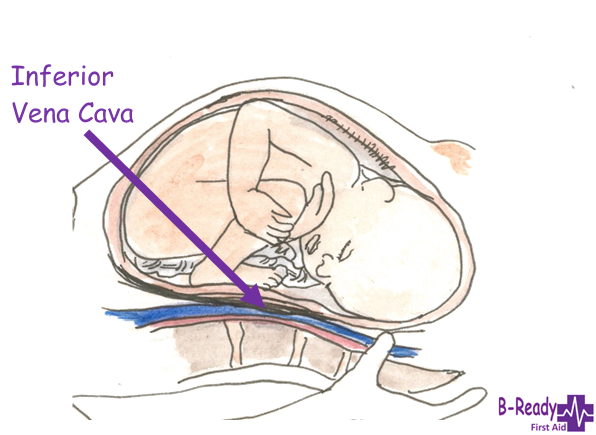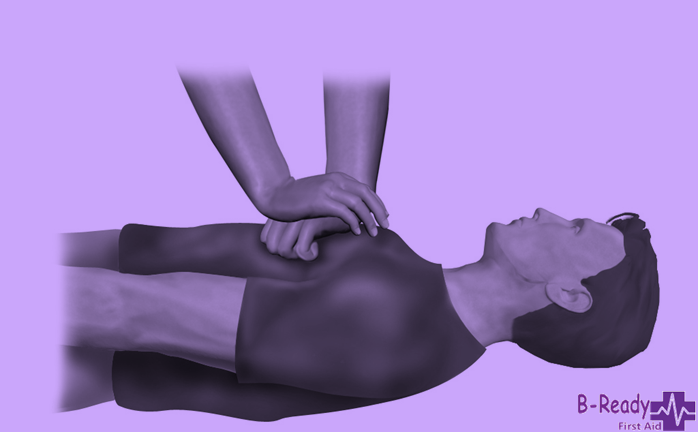|
Yes, I think you might have a clue from the picture, that this relates primarily to those carrying a child & typically in the last trimester of pregnancy or when visually pregnant. Specifically speaking about the inferior vena cava as it is the largest vein in the body and carries de-oxygenated blood from the lower part of the body back to the heart & lungs to be re-oxygenated. The blood enters back into the heart through the right atrium of the heart. It also has valves to stop blood flowing, in a downward direction with gravity. Isn’t the body marvellously made! A vein is not like an artery that, which has thicker vessel walls. Therefore, this large diameter vein actually has very thin walls and can be put under pressure causing the blood traveling back to the heart to be either restricted or even completely stopped. It lies to the right side of the vertebral column in the abdominal cavity. Why do we think of this for those mum’s to be? Imagine if the blood flow is limited to both mum and bub during a first aid emergency. If CPR is required start straight away don’t delay and if there is something you can utilize available, chock up her right hip at approximately 15-30 ◦. We suggest something such as a rolled-up towel, jumper, her handbag, pillow or cushion. This will move the baby and fluid etc to her left off the uterus and off the right side where this major vein is located. This is not to compromise the quality of compression's so it is best if their shoulders remain flat.
If your casualty is unconscious and breathing normally then there is no need to commence CPR, PHEW! However, they still need to be placed into the recovery position and guess which side that should be! “Labour to their LEFT” is the saying we teach for you to recall this when needed. How do you remember? This is stated in the Australian Resuscitation Council ANZCOR Guideline 6- Compression's ‘There are no published studies of optimum positioning in pregnant women undergoing cardiopulmonary resuscitation (CPR) so recommendations to date are extrapolated from manikin studies or studies of pregnant women who are not in cardiac arrest.’
1 Comment
This is a small cartilaginous extension of the lower part of the sternum or breastbone, just below where the ribs meet at the bottom tip. It is the smallest & lowest part of the sternum. At birth it is a thin and roughly a triangular shape which hardens in adult hood and fuses to the sternum, approximately between 15 and 29 years of age. It even flexes if you press it gently. It is a vital attachment point for several major muscles such as the diaphragm. In teaching CPR, we direct students to find the ribs, work your fingers up to where they meet, place a finger there and then place the heal of the hand above the finger position, towards the casualty's head. You can see just how close to the Xiphoid process that is. Much care should be given not to apply pressure as it is unsupported and can be injured, fractured, dislocate or even break away causing damage to various organs. This could puncture or lacerate the diaphragm or the liver, which as you can imagine is not helpful to a person who also requires CPR. Do take care but remember, ANY ATTEMPT IS BETTER THAN NONE!I know what I do, but......I have changed my career a few times over the years & have always thought I wonder if I really do make a difference to someone, anyone's life. Connecting on social media has allowed me to hear some feedback over the recent years (all positive) & gee I'm so grateful for people taking the time to let me know. I celebrated 9 years at the beginning of this year (2017) training CPR & First Aid skills to thousands of people. I strive for continual improvement & really love my job & feel so blessed to be in the industry. I know what I do but sometimes it really hits you like a ton of bricks especially when you hear from students & businesses that what you taught them made such a difference. Let me share one of those stories.
|
AuthorI'm all about educating those who have completed a First Aid Course & those that haven't....... You can B-The one to make a difference so B-Ready! Archives
February 2018
Categories |
We Would Love to Have You train with us!
HoursOffice hours
M-Th: 9am - 5pm F: 9am-4pm |
Telephone |
|














 RSS Feed
RSS Feed


